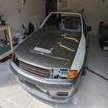R32 Gtr Aac Valve Refurbishment
Announcements
-
Similar Content
-
Latest Posts
-
I mean it's probably likely that people overestimate their skills in dialling in a setup and noticing the changes. I had SK shocks and springs, and added heavier springs and got them revalved by Sydney Shocks to suit based upon what I told them I wanted the car to handle like. I got back a completely different feeling set of shocks, which probably (?) feel great on track but holy hell are they rough on tram tracks and the like. Truth be told I doubt I'd be any faster or slower with either setup, or camber/castor combination. I also had whiteline eccentric castor bushes up front of my R34. I removed them and put in poly non-adjustable ones to soothe my OCD (nobody ever set the castor the same side to side, and it'd be near impossible to do) and be happy the wheel is centered in the well now for clearance reasons. Yes I wanted it to move 1mm 'back' :p I've effectively set my castor back to stock, negating all the benefits of that which is supposedly massive. I can't tell any difference steering the car.
-
You reckon? I have to disagree. Notwithstanding that at some point we may all be forced to do this to our cars if we want to keep driving them, there is absolutely nothing about an electric-converted-previously-IC-car that is ever good. EVs that are built by OEMs on platforms that were originally IC already suck, let alone the shitty outcomes that result from doing it as a retro to something that was actually built as an IC car. This is because the platform really needs to be designed to house the battery in a useful place (ie, down as low as possible) and the motors are properly located relative to the wheels that they have to drive. Converted platforms already suck at this. But when you try to shove sufficient battery capacity into a previously IC car, you can't put it down on/in the floor, because that space doesn't exist. You can't find enough space where the fuel tank used to be (if it is an inboard fuel tank) and you don't want to hang it out behind the rear axle line if you had a rear fuel tank. And there's not enough space in the tunnel if you still want to use it for anything remotely like what it was originally used for. The engine bay is too big for a motor, and you'd really prefer that the motor for the rear wheels wasn't in the front engine bay anyway. And there's not enough room where the diff was for a proper man-sized E motor. And then.... there is the complete lack of soul and emotion that is provided by EVs. There are some cracking restomods out there. Like the Alfaholics GTA thingo. But it is petrol powered. Look at the alternative EV version of a GTA restomod by Totem. it is jaw droppingly beautiful. But by all reports is is objectively awful to drive, despite having 600 HP or something, simply because there is nothing there. It sounds like a sewing machine or a leaf blower. It should scream and wail and make the hairs on your neck stand up. Oh, and it's 1500 bloody kg in a car that was <900kg when new. GTRs are heavy enough as it is without pushing them up to 2tonnes worth of pork.
-
https://www.dezeen.com/2025/01/06/nissan-electric-r32-skyline-gt-r-godzilla-sports-car/ I reckon this is pretty cool. Lots of other Resto mods have turned to ev power.
-
By DraftySquash · Posted
hahaha @joshuaho96 the most action it gets is when I have to drive from West to SE VIC to meet the fam. Even then, it;s on highway cruising speeds -
By thatjawncrazy · Posted
don't know anyone in this thread, but i just found it, read the entire thing in a few hours, realized greg is still posting progress, and just have to say, this is awesome. it looks awesome. 100% right about the Uras kit making it a pain to get on hoists...have the same kit on my 34 and it takes six 2x4s and race ramps to do it without taking parts off. this reminds me exactly of this thread. https://grassrootsmotorsports.com/forum/build-projects-and-project-cars/r63-amg-the-unicorn-of-my-destruction/110824/page8/
-







Recommended Posts
Create an account or sign in to comment
You need to be a member in order to leave a comment
Create an account
Sign up for a new account in our community. It's easy!
Register a new accountSign in
Already have an account? Sign in here.
Sign In Now